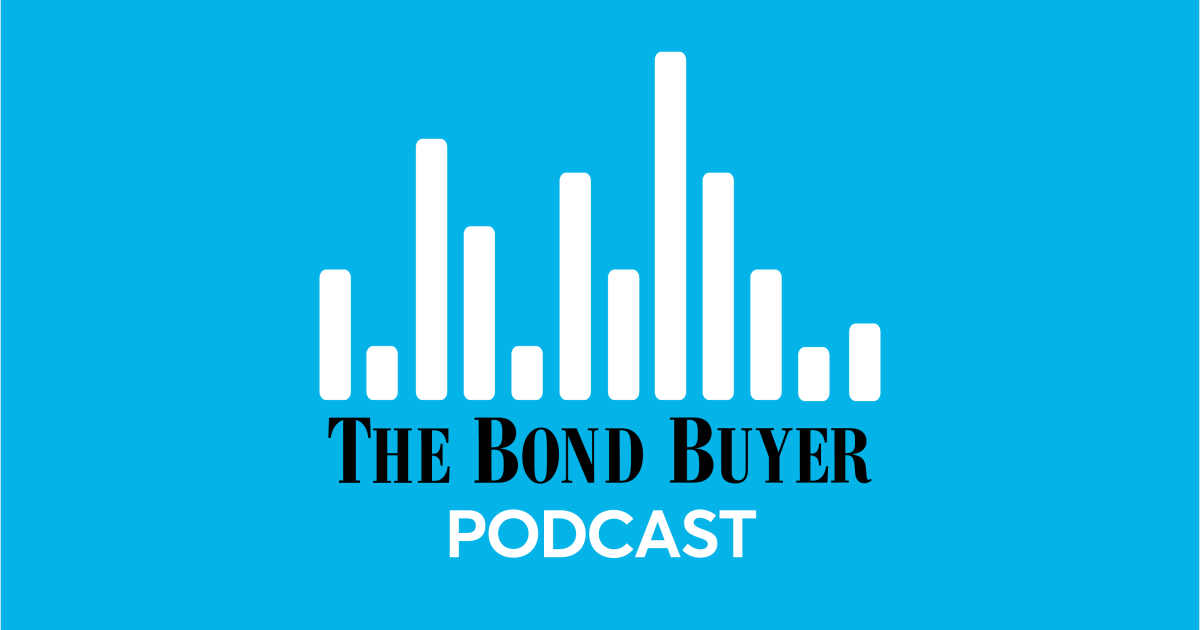A midyear look at the market — a bullish take on the second half
15 min read

Transcription:
Jessica Lerner (00:03):
Hello everyone and welcome to another Bond Buyer podcast. I’m Jessica Lerner, markets reporter at the Bond Buyer. I’m happy to welcome Nick Venditti, municipal bond portfolio manager with Allspring Global Investments. Welcome, Nick.
Nick Venditti (00:18):
Thank you so much for having me.
Jessica Lerner (00:19):
Yeah, it’s great to talk again. The first half of the year has been a whirlwind. The market has faced unexpected volatility, regional banking woes, the debt ceiling impasse and uncertain federal reserve policies. In the months to come, market participants hope the second half of the year will be better. We’ll talk about that and more today. To start with muni-to-U.S. Treasury ratios remain rich on the short end. Despite the lower ratios, yields are still relatively high from a historical perspective. You said in a story from May that “income was back in fixed income.” Where do you see rates for the next few months?
Nick Venditti (00:58):
I don’t know. Somewhere, right? Look, that, that’s a really, really complicated question because as you said in the introduction, 2023 was supposed to be the year of stability, right? We got rocked. We all went on an incredible rollercoaster ride in 2022. We thought coming into 2023, we knew when the Fed was going to stop, everything was going to calm down and volatility would subside, and clearly, that hasn’t happened. It appears that we are in for at least one and maybe two additional Fed rate hikes, which is going to continue to pressure rates at least somewhat higher. I think the good news though, for fixed-income investors is that rates, particularly longer on the curve in that 10-year space, are starting I think to get pretty close to the top end before we end up in a spot where we have to start pausing from a Fed perspective and at some point begin to cut rates and move them lower.
Jessica Lerner (02:03):
So in that same story, you also mentioned that retail was hesitant to enter into munis due to the volatility most asset classes faced last year. Has anything changed since then?
Nick Venditti (02:15):
Well, I think fixed-income has gotten a lot more attractive, right? You mentioned income is back in fixed income, and the reality is that every investor, every investor is facing a similar problem. They got burned in 2022, and they can still see those burn marks fresh on their arms and legs and frankly everywhere else. And money markets are yielding a lot, a very, very big number. And so it’s pretty easy to fall into the psychological trap that, “Hey, if I can invest in something with no risk for a very, very high yield, maybe I should just stay here.” The problem without assertion is that money market yields are ephemeral. There is significant reinvestment risk associated with them, and so at some point, it’s going to behoove investors to get into the game, to get that money on the curve, and ultimately I think we will start to see that happen over the next several months, which should provide a pretty interesting technical tailwind for municipal bonds.
Jessica Lerner (03:26):
What about issuance? During the first half of the year, issuance was down 20% from 2022, which was already a down year. Some strategists expect issuance to pick up in the second half of the year. What are your thoughts on this and why does it matter?
Nick Venditti (03:42):
Yeah, supply is low, right? Supply was low in 2022 for the same reason that there were no IPOs and for the same reason no one has said the words back in 18 months, right? Capital markets froze up in a year of incredible volatility. 2023 has been lower still, it’s been lower still because as it turns out, nothing on earth says, “I love you like cash.” And we wrote a $5 trillion stimulus check and a bunch of that money showed up directly on municipal balance sheets, and that money has allowed municipal issuers to kick the can one block further down the road. And so they haven’t been forced to come to market with new paper. The reality though is that the country we live in, from the smallest municipality to the federal government, is debt-financed. And so eventually that supply will come. It’s certainly important because that supply-demand balance really tells the story of muni total returns over short and sometimes longer periods of time. The good news is I think demand is robust enough to meet supply if and when it starts to tick up, but that probably won’t happen until the later part of this year.
Jessica Lerner (05:09):
Sticking with demand, most of 2023 has seen outflows from muni mutual funds — albeit not to the record levels of 2022. Over the past few weeks, there have been some inflows, but the most recent week saw $856 million of outflows according to Refinitiv Lipper. What do you think will happen with mutual funds?
Nick Venditti (05:32):
Yeah, as I mentioned, I think demand is coming. I think demand is coming for a couple of reasons. One, because all of those money market assets need to find a more permanent home. And I think municipal bonds look awfully attractive as an option, certainly from a risk perspective, but also from just an absolute yield perspective. And if we can stick with that absolute yield comment for just a minute more, I think munis look awfully attractive relative to almost any other asset class, frankly, on earth. Look, if you are a 37% taxpayer and every day you go into the market, every day all of us as investors go into the market and we try to solve kind of a very basic equation. And that equation looks something like X plus Y equals eight, so that we can eat, so that we can retire, so that we can send a kid to school someday, whatever we need to spend money on.
(06:39)
And if you can go out today and buy a municipal bond portfolio with a duration of four, with a yield of four, and you are a 37% taxpayer, well a 4% yield grosses up to almost six and a half. If the X in your equation is throwing off six and a half, it takes a lot of pressure off what the Y needs to do in order for you to meet your investment goals. Fixed income holistically looks very attractive given where rates are, and I think that’s going to spur continued investment into those asset classes, including munis.
Jessica Lerner (07:22):
Have SMAs and ETFs continued to step in and fill some of that void in the short term?
Nick Venditti (07:29):
They have. Look, muni ETFs and muni SMAs have been a consistent buyer, but I would caution that particularly SMAs are focused in a very narrow portion of the market, right? SMAs tend to only invest in high-quality bonds in a one- to 10-year laddered structure. So those bonds have continued to receive a very, very strong bid. But ultimately for investors looking for more than just beta exposure to the muni market, they’re going to have to be willing to branch out behind those sort of Boy Scout, sleep easy at night bonds, and do something a little bit more interesting. And so relying on the segments of the market that are populated by SMAs and ETFs, while in the short term has looked beneficial, I think in the long term investors who are willing to take a little bit more risk to do a little more interesting things will be compensated for taking those actions.
Jessica Lerner (08:36):
We need to take a short break, but we’ll be back with more from Nick Vendetti. We’re back with all springing global investments. Nick Vendetti. Before the break, we were talking about demand from both mutual funds and SMAs and ETFs. What about crossover? Do you see any crossover interest in the asset class, P&C insurance companies, foreign investors?
Nick Venditti (09:02):
We’ve seen some, it’s a little bit difficult as of today given where muni-to-Treasury ratios are, but I look, I would caution investors that muni-to-Treasury ratios are only one half of the equation, right? That’s comparing yield to yield, not total return to total return. And in spite of the fact that ratios seem challenged from a municipal bond perspective, it doesn’t mean that municipal bonds aren’t well positioned to perform and perhaps outperform some of their fixed-income brethren, particularly those with more risk associated with them. So the crossover interest we have seen either from kind of more institutional buyers or even overseas buyers has been as a result of those buyers wanting less volatility, wanting higher absolute credit quality and wanting an asset class, frankly, that is less correlated to everything than everything, which may pay off as volatility across all markets continues to persist.
Jessica Lerner (10:14):
Switching gears a little bit, July 1 marked another heavy reinvestment period, and some say August reinvestment will be even greater. How has this money coming back into the muni market affected market performance?
Nick Venditti (10:29):
Look, I think that’s another technical tailwind that’s likely going to support municipal bonds throughout the remainder of the year, right? We have organic cash flows coming from maturities coupon payments in the summer months. We likely have inorganic cash flows coming from investor interest given the absolute higher yields. And all of that paints a pretty interesting backdrop. The one caveat that we’d be remiss if we didn’t mention is obviously the Fed. In spite of the fact that we just received pretty healthy coupon and maturity payments, the market has backed off on the heels of fairly aggressive commentary out of the Fed around con the continued need to fight inflation. So that dark cloud still is overhanging, but the reality is inflation numbers look a lot better than they did six months ago. They’re still higher than the Fed wants, but we are on the right track. So ultimately, I think even with the Fed acting in the background, both the technical and fundamental characteristics of the municipal bond market make it awfully attractive for muni investors.
Jessica Lerner (11:47):
So will muni returns continue to perform well? Muni returns were positive in June and year-to-date. Where do you see performance over the remainder of the year? And are there opportunities despite the dearth of supply?
Nick Venditti (12:02):
Yes. Look, munis are going to continue to perform well. In fact, with all of the volatility that we’ve mentioned that exists in the world, I think munis are poised to return very well relative to almost everything. And to be fair, year-to-date, munis have performed pretty well relative to almost everything. It’s pretty easy to look at headlines S&P numbers and see basically a home run. But the reality is that those numbers are largely driven by a handful of stocks. If you look at equal-weighted S&P year-to-date, municipal returns are essentially on par. Your municipal bond portfolio is keeping up with the S&P 500 on an equal-weight basis. That’s a pretty attractive prospect for investors who are looking for risk-relative return. And ultimately, I think that same dynamic continues to play out as we likely enter into an economic slowdown as we see continued volatility across markets, and as we likely see continued volatility from a geopolitical perspective. Munis to a large degree isolate investors from a lot, a lot of that noise, and when they are throwing off consistent, stable, durable, and more importantly, high tax-exempt income, given the recent move in rates, it looks like a pretty attractive time to enter the market for investors.
Jessica Lerner (13:39):
So you mentioned a potential slowdown or recession. How do you feel generally about muni credit, given that you mentioned earlier that federal stimulus that now is drying up and some issuers are signaling smaller tax collections. Are there any pockets of concern or sectors to watch?
Nick Venditti (13:58):
Absolutely. Look, I think the easy answer from someone who sits in a chair that sort of looks like mine will be, “Hey, muni credit looks good” because it does, but only in a vacuum, right? It looks good because as we mentioned earlier, we wrote a big stimulus check and that showed up on muni balance sheets and that kind of money hides sins, sometimes awful, awful sins. So many sins that you saw perennial headline muni risk get upgraded. The state of Illinois was upgraded for the first time in 25 years. Muni credit looks good, but muni issuers are bleeding through that cash at a fairly rapid rate, and ultimately they will need to access the markets again. Ultimately, they will find themselves in the same fiscal position or at least a similar fiscal position to the one that they were in pre-Covid-19. And what does that mean for investors?
(15:03)
Well, it doesn’t mean Armageddon. It’s not the end of the world, but it does mean that you need to be cognizant of the fact that when you buy a bond that matures in 10 years, you are effectively getting into bed with that issuer for the next 10 years. And so it’s not so much how muni credit looks today, but how you expect muni credit to perform over the cycle. And if we do enter into a recession, an economic slowdown, wherever you want to gauge that, right? It could be anything from oh, soft landing all the way to “Grapes of Wrath” depression. Wherever you fall on that scale, you have to be biased, at least a little bit to some credit spread widening. And so ultimately, investors should be cognizant of the fact that muni spreads could widen a little bit, and they should be prepared to take advantage of that spread widening when they’re being compensated for it, but also be ready to take their foot off the gas to take less risk when that credit trades too expensive for the risk that it represents.
Jessica Lerner (16:10):
On a slightly different note, did you follow the FDIC’s liquidation of the failed banks? The sales are coming to an end. How did the market handle them, did you buy any, and now that they’re gone, will that help or hurt the secondary market?
Nick Venditti (16:26):
They were handled really well, shockingly well in fact, given certainly all of the noise that was surrounding the banks and the issues they were facing, and particularly because the type of paper those banks held was weird. It was weird from a structural perspective, very low coupon debt that the market generally doesn’t love to gobble up aggressively, certainly not after 2022 in which a year in which low coupon debt significantly underperformed. But I think there is demand for paper. As you mentioned Jessica, flows have turned slightly positive, mutual funds, SMAs ETFs are looking to get invested. Investors are looking to get a little bit more aggressive, at least on the margins, given where absolute yields were. And by virtue of that, those lists were really well received for the most part.
Jessica Lerner (17:34):
So do you think then that shorter coupons have a place then in the market?
Nick Venditti (17:39):
Sure. I think investors need to be careful with them, though. Look, the proliferation of lower coupon paper was really a result of the fact that we were living in a world in which interest rates were zero, and investors were desperate for any kind of yield they could get their hands on. And one of the ways that municipal issuers found to generate demand for their paper was to issue bonds with a lower coupon, which was advantageous for them at a slightly higher yield, which was advantageous, at least on the surface for municipal bond buyers. The issue that created was that you were buying bonds very close to par, and when interest rates went up a lot and quickly, those bonds started trading at a steep discount very, very rapidly. And there are tax reasons that I won’t bore your listeners with that really lead people away from buying bonds that are close to what they call the de minimis level, where the accretion of that bond of the discount back to par becomes taxable to them at ordinary income, and that reality caused that low coupon payment to significantly underperform.
(19:05)
But we’re in a new world, right? We’re in a world where rates are much, much higher, where you can buy some of that low coupon paper at significant discounts. And at significant discounts, they have very, very interesting total return prospects on a go-forward basis, or at least the potential for very interesting total return prospects on a go-forward basis. So the reality is there are certainly opportunities to take advantage of those types of bonds. I wouldn’t say to your listeners to go wholesale out and buy every one they find, but for the right situation at the right price, there’s a real opportunity to generate alpha by taking a little bit of structure risk in this market.
Jessica Lerner (19:54):
So do you see any room for taxable munis in this higher rate environment?
Nick Venditti (20:00):
Oh, so taxable munis were very, very interesting for two reasons. One, taxable muni issuance exploded post the Tax Reform Act. Essentially, as you and your listeners are well aware, municipal issuers lost the ability to advance refund their debt into the tax-exempt market, but because absolute rates were so low, they could still realize economic savings by essentially refinancing their debt in the taxable market. So they did that, and they did that aggressively, which caused taxable supply to explode, right? It grew by gangbusters, and that should have been bad for the market, but at the same time, that supply increased dramatically, demand rose to meet it and demand rose because institutional buyers of munis think insurance companies primarily just saw their corporate income tax rate fall pretty dramatically. And so from their perspective, the value of the tax exemption went down, but they still liked munis.
(21:13)
They liked them because they were lower risk, because they had better credit quality and because they were a diversifier, and so all of a sudden they wanted to buy all of that taxable paper. Fast forward to today, and muni issuers can’t achieve economic savings from refinancing their debt in the taxable market because rates have gone up as aggressively as they have, and that means that taxable supply has fallen off a cliff. So can taxable munis be a robust market? Maybe, maybe, but it largely depends on whether or not issuers kind of from a holistic perspective, find a need either from a refinancing perspective or because they like the more robust demand or they like the flexibility of the taxable market. If they find that need and start issuing paper, perhaps that market can return to some prominence. But right now it looks like it’s going to drift back to what it was pre-Covid-19 where it’s kind of a fraction of the total municipal bond market as a whole.
Jessica Lerner (22:28):
This has been great. What else are you following in the market? Is there anything else I did not ask you that you think our listeners should be thinking about?
Nick Venditti (22:37):
I mean, I think we’ve covered a lot here, but I would just reemphasize the fact that on a risk-relative basis, fixed income looks very attractive to me. I think if you are a high taxpayer, not necessarily 37%, but if you are in the upper echelons of the tax bracket, muni fixed income looks particularly interesting. We hit on the fact the economy is almost certainly slowing down, and that generally doesn’t make for a very nice backdrop for equities or other high volatile asset classes, but it does historically support fixed income. I think this is a great opportunity to enter fixed-income markets, to take advantage of these high yields and ride those returns into 2024 when the Fed finds themselves in a position where they have to cut rates. So ultimately, muni’s look good is the message that I’m, I’m delivering here today.
Jessica Lerner (23:41):
Well, I’m sure our listeners are glad to hear that. Thanks so much, Nick, for joining me today. I know this conversation will continue.
Nick Venditti (23:50):
Thank you. I appreciate the time.
Jessica Lerner (23:51):
Of course. It was a pleasure to talk with you, as always. Thank you for listening to this Bond Buyer podcast. I produced this episode with the audio production by Kevin Parise. Special thanks this week to Nick Venditti of Allspring Global Investments. Rate us, review us and subscribe to our content at www.bondbuyer.com/subscribe. From the Bond Buyer, I’m Jessica Lerner and thanks for listening.







